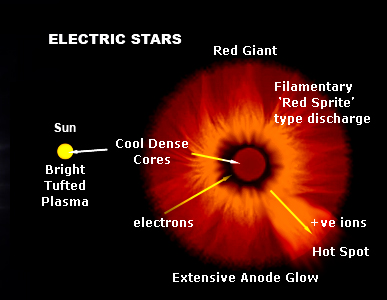Confrontational and condescending.jw: Which is it there plasma people?
New insight? Mad idea?
Old news? Obvious idea?
I think it's obvious. So I explained it. I did what Copernicus did. I have explained something that has baffled humanity for thousands of years.
It's not a difficult theory to read I promise. A 5th grader can understand.
lloyd: "planets sometimes result from fissioning from the star and ejected"
-jw: This is not scientific because it has never been observed. Solar flares are observed but no planets the size of Earth come flying out. Unless you know something I don't.
Lloyd wrote:* Jeffrey said regarding "planets sometimes result from fissioning from the star and ejected"..---
jw:
"This is not scientific because it has never been observed".
Lloyd * I think it's scientific to make hypotheses. Comets are known to fission, and stars appear sometimes to explode, which means they may end up in two or more pieces. Some ancient myths sound as if the ancients may have witnessed Venus fissioning from Saturn or Jupiter or something. So fissioning seems to be a reasonable hypothesis. Besides, I think it would even fit into your theory fairly well.
* I haven't read your theory in detail, but I skimmed through it. We could probably learn quite a bit from each other, if you'd post brief summaries of each phase of your theory and let us comment and refer you to other information that may help develop your theory more thoroughly. Your theory that I saw seems to lack references to data etc, and that's something scientists want to see with any theory. Your idea about rock formation seems likely to be inaccurate, since some scientists have found that many layers of rock tend to form all at once from flooding and the like, that is before they become hardened. We can help you find such info, if you like.
jw:Do I need references to state that the Earth is a giant ball? Or that it orbits around the sun? Do I need acceptance from "scientists"? No! I am the best scientist. I do science! I do explanation. I do not require degrees or labels or acceptance or nobel prizes nonsense. This is for the birds!---
This is not difficult to understand. I have already explained it to my 7 year old niece.
Arrogant and dismissive! Lloyd offered to help, which it appears that jw needs.
But jw prefers to confront and dismiss all such suggestions with condescending, if not arrogant pufferey.!
A reasonable answer, ignored by jw!Lloyd:- "novas and supernovas do occur and that's very similar to fissioning."
So, what is it Jeffrey, coming in with a confrontational attitude and arrogance, while
expressing a dogmatic, bald assertion! Does anyone at TB qualify to understand your very complicated hypothesis?

